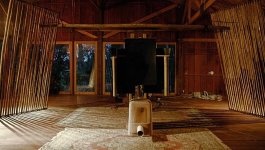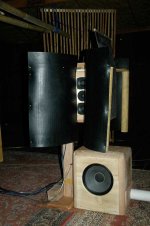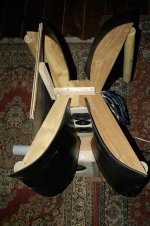Not possible. My walls are already giving all the efforts they can.
- Elias
perhaps the sidewalls are a bit too close? 3.5 m of Your room width is relatively narrow
OTOH I think that Your 3.5x7 room would be just perfect for a flooder sidewall arrangement
perhaps the sidewalls are a bit too close? 3.5 m of Your room width is relatively narrow
OTOH I think that Your 3.5x7 room would be just perfect for a flooder sidewall arrangement
Moving the walls furhter will not increase the level of the reflections, but decrease of course due to longer path length compared to direct sound.
- Elias
Moving the walls furhter will not increase the level of the reflections, but decrease of course due to longer path length compared to direct sound.
surely it won't but who knows what principles exactly are operating here 🙂
after all those tests done so far, including my own, my conclusion is that even quite counterintuitive arrangements should be tested
and there is always the critical factor - loudspeaker and room as a system
Last edited:
Not possible. My walls are already giving all the efforts they can.
- Elias
Angle the speakers towards the front wall. This will result in increased level of reflections and decreased direct sound.
Angle the speakers towards the front wall. This will result in increased level of reflections and decreased direct sound.
uhm Markus what are you talking about? how is Elias supposed to angle his carboard box towards the front wall? 😉
You can angle a cube on paper but it is quite difficult to angle a paper cube without crushing it 😀
Angle the speakers towards the front wall. This will result in increased level of reflections and decreased direct sound.
No, it will lower both the direct sound and first lateral side wall reflections.
I want to control the level of direct sound and side wall reflections independently, thus I'm testing with the pillow.
- Elias
No, it will lower both the direct sound and first lateral side wall reflections.
I want to control the level of direct sound and side wall reflections independently, thus I'm testing with the pillow.
- Elias
I don't think one single reflection is responsible for added spaciousness and spatially distributed high frequency phantom sources. It's the sum of all reflections. They need to reach a certain level to be effective.
You could also try to use a porous absorber to attenuate the direct sound without making the baffle too wide. I believe the baffle must not become wider than about 20cm for the speaker to be perceived as a single source. If it gets wider pinna localization cues become ambiguous again.
The underlying problematic is how the frequency response of the direct sound, the reflections and the overall power response need to look like.
The underlying problematic is how the frequency response of the direct sound, the reflections and the overall power response need to look like.
how do they look alike in case of the original Stereolith?
and let me take this opportunity (for the fifth time) to draw Your kind attention to couple of my questions posted above that You haven't asnwered yet, in case You didn't notice them:
You experience with what? What's the setup?
from:
http://www.diyaudio.com/forums/multi-way/10962-stereolith-loudspeakers-question-44.html#post2527585
are they working in one volume or is there any kind of partition inside? from:
http://www.diyaudio.com/forums/multi-way/10962-stereolith-loudspeakers-question-33.html#post2523007
what is exactly pretty amazing about it?
and
Do You mean AVR + an upmixing algorithm?
from:
http://www.diyaudio.com/forums/multi-way/10962-stereolith-loudspeakers-question-40.html#post2525359
and
Could You be a little bit more specific? Which conlusions exactly?
and
What is more to it?
and
which book?
from:
http://www.diyaudio.com/forums/multi-way/10962-stereolith-loudspeakers-question-40.html#post2525362
best!
graaf
Last edited:
A step further with the great Finland Pillow Technology.
I was already satisfied with one frontal barrier, the system was finally imaging . I tried an other barrier on the back of the speaker, but it's not good at all : dramatic reduction of the spaciousness, narrowing, dull...something wrong.
Anyway, this kind of straight asymmetric barrier is quite primitive, is there some better options?
Look at this :
I was already satisfied with one frontal barrier, the system was finally imaging . I tried an other barrier on the back of the speaker, but it's not good at all : dramatic reduction of the spaciousness, narrowing, dull...something wrong.
Anyway, this kind of straight asymmetric barrier is quite primitive, is there some better options?
Look at this :
Attachments
I tried an other barrier on the back of the speaker, but it's not good at all : dramatic reduction of the spaciousness, narrowing, dull...something wrong.
Can you show a picture of that barrier?
The perfect dream of the housewife, with integrated phallic symbol, or viewed from the front, an allegoric representation of the Flying Dutchman?
As you see, the barrier became a couple of wave guides, actually only on the vertical plane. The expansion is an exponential secret variant, I bet it would work the same if not better with a conical.. The material is a 5mm thick soft synthetic rubber that can't vibrate and blocks many frequencies. Not measured this yet, but I think that 1000 Hz is very attenuated in the frontal direction.
When measuring the Fr with a huge window, there is a 6 dB increase kind of Q=1, centered on 600 Hz, a wave guide effect.
But when reducing the window "as usual" (15 ms) , it's an energic 2nd order shelving starting early after 300 Hz, the boomers stays untouched and all the rest comes now from the reflections. The step confirms this.
just before markus said :
that's right...here I have to deal with the power response more than with the direct sound.
As you see, the barrier became a couple of wave guides, actually only on the vertical plane. The expansion is an exponential secret variant, I bet it would work the same if not better with a conical.. The material is a 5mm thick soft synthetic rubber that can't vibrate and blocks many frequencies. Not measured this yet, but I think that 1000 Hz is very attenuated in the frontal direction.
When measuring the Fr with a huge window, there is a 6 dB increase kind of Q=1, centered on 600 Hz, a wave guide effect.
But when reducing the window "as usual" (15 ms) , it's an energic 2nd order shelving starting early after 300 Hz, the boomers stays untouched and all the rest comes now from the reflections. The step confirms this.
just before markus said :
The underlying problematic is how the frequency response of the direct sound, the reflections and the overall power response need to look like.
that's right...here I have to deal with the power response more than with the direct sound.
Listening this will then be listening :
So, this works pretty well. There's not a huge slam, but it's effortless, a very relax listening, only with lateral and vertical reflections.
@ markus :sorry, no pics , but easy to imagine, this back barrier was an other same rubber stuck behind the speaker
- with a very reduced direct sound
- with very reduced front wall reflections
- the speaker is 90 cm wide, placed at 5 meters from the front wall and 4 m from the listener
- as you see, there is two big HF diffusers and one at the ceiling that you don't see.
- less global fuzzy spaciousness
- same width, but now it's full, more populated
- imaging is more contrasted, stable
- the recording venue reflections are well defined
- the centered sources are not fragilized
- It' ok with phase or intensity stereo
- all the demos are satisfying, including the ISVR and the markus toms
- the listening spot is almost anywhere except in the waves guides axis
So, this works pretty well. There's not a huge slam, but it's effortless, a very relax listening, only with lateral and vertical reflections.
@ markus :sorry, no pics , but easy to imagine, this back barrier was an other same rubber stuck behind the speaker
Can you show a picture of that barrier?
can You show anything specific about Your stereolitic setup?
Listening this will then be listening :
My feelings :
- with a very reduced direct sound
- with very reduced front wall reflections
- the speaker is 90 cm wide, placed at 5 meters from the front wall and 4 m from the listener
- as you see, there is two big HF diffusers and one at the ceiling that you don't see.
- less global fuzzy spaciousness
- same width, but now it's full, more populated
- imaging is more contrasted, stable
- the recording venue reflections are well defined
- the centered sources are not fragilized
- It' ok with phase or intensity stereo
- all the demos are satisfying, including the ISVR and the markus toms
- the listening spot is almost anywhere except in the waves guides axis
So, this works pretty well. There's not a huge slam, but it's effortless, a very relax listening, only with lateral and vertical reflections.
finally success, a well-deserved one!


 😀
😀my name for this is a CG-waveguide 😉

Hello,
Binaural impulse responses measured at the listening position. One element of cardboard playing, other element mute. My dummy head proto is, again, made using a pillow ! 😀 Using pillow size close to the size of a head. Two measurements, microphone placed on both side of the pillow.
Right element to right ear:

Right element to left ear:
(this is cross talk)

See the direct sound at 0 ms.. cardboard provides 2-3 dB of cross talk cancellation between 1 - 5 kHz. I think it is too little for the principle to rely on direct sound with amplitude panned recording.
The cluster of side wall reflections at 6-10 ms (right element to right ear) contains the energy that is perceived as imaging in summing localisation.
It's nice to have a dummy head 😎
- Elias
Binaural impulse responses measured at the listening position. One element of cardboard playing, other element mute. My dummy head proto is, again, made using a pillow ! 😀 Using pillow size close to the size of a head. Two measurements, microphone placed on both side of the pillow.
Right element to right ear:

Right element to left ear:
(this is cross talk)

See the direct sound at 0 ms.. cardboard provides 2-3 dB of cross talk cancellation between 1 - 5 kHz. I think it is too little for the principle to rely on direct sound with amplitude panned recording.
The cluster of side wall reflections at 6-10 ms (right element to right ear) contains the energy that is perceived as imaging in summing localisation.
It's nice to have a dummy head 😎
- Elias
Hello,
Binaural impulse responses measured at the listening position. One element of cardboard playing, other element mute. My dummy head proto is, again, made using a pillow ! 😀 Using pillow size close to the size of a head. Two measurements, microphone placed on both side of the pillow.
Right element to right ear:

Right element to left ear:
(this is cross talk)

See the direct sound at 0 ms.. cardboard provides 2-3 dB of cross talk cancellation between 1 - 5 kHz. I think it is too little for the principle to rely on direct sound with amplitude panned recording.
The cluster of side wall reflections at 6-10 ms (right element to right ear) contains the energy that is perceived as imaging in summing localisation.
It's nice to have a dummy head 😎
- Elias
The localization is still from direct sound. Again, something you'll need to test outside (..when the weather is better for you of course). 😉
From 4 kHz to a little under 2 kHz there appears to be MORE than a 5 db difference - which is almost 3 times as loud. That's a pretty big difference. Above and below that however I'd say your estimate is more accurate, and could use a little more "shading". 🙂
a 5 db difference - which is almost 3 times as loud.
"3 times as loud" equals 16dB, no?
The localization is still from direct sound. Again, something you'll need to test outside
What did the loudspeakers you've tested outside look like? How far were the drivers spaced? What driver size? Were the drivers side firing or mounted on a single baffle?
"3 times as loud" equals 16dB, no?
oops, 6 db *doubling* (..or rather almost twice as loud). (..not tripling). 😱 (..includes bias adjustment.)
Last edited:
What did the loudspeakers you've tested outside look like? How far were the drivers spaced? What driver size? Were the drivers side firing or mounted on a single baffle?
Again, similar format - 4 inch drivers on sides with diffraction reduction (shaped cardboard and lots of tape). Small box (slightly larger than a human's head), looking rather like a packaging/shipping nightmare. 😀
The "test" is simply to see if imaging "collapses" to the loudspeaker in the frontal axis (of the loudspeaker) outside (golf-course green) without significant reflections - which it didn't. Imaging was however *closer* to the speaker than when operated in a room of 20 by 15 by 9 (feet) (..centered placement between side-walls, or about 7 feet from a side-wall).
- Home
- Loudspeakers
- Multi-Way
- Stereolith Loudspeakers Question


